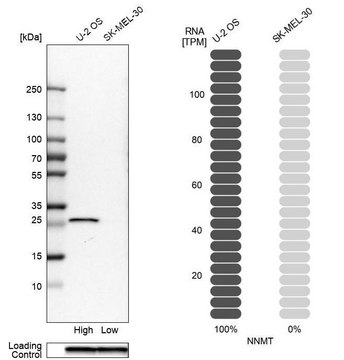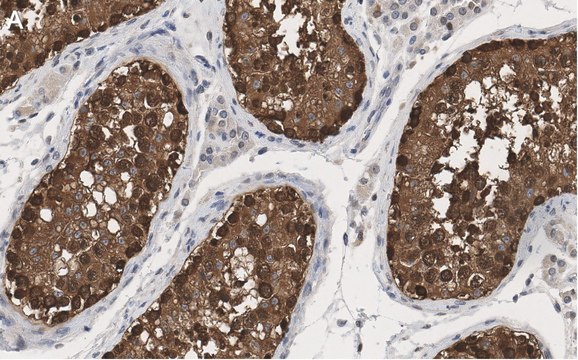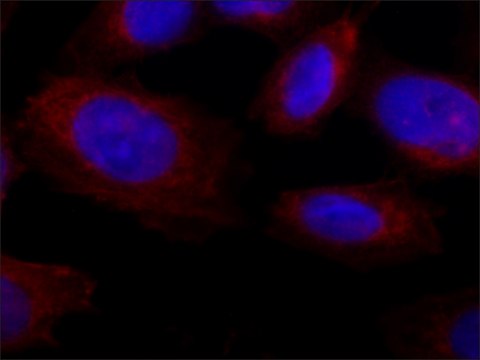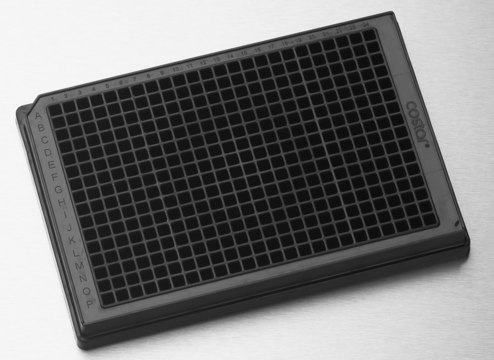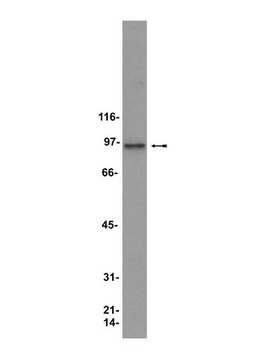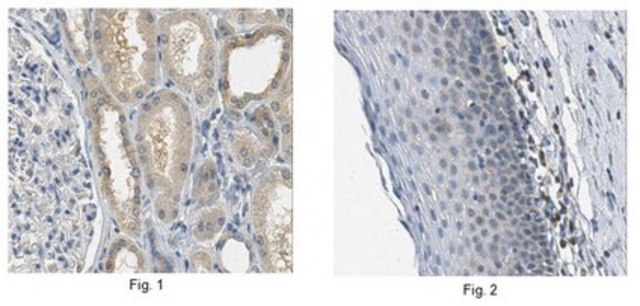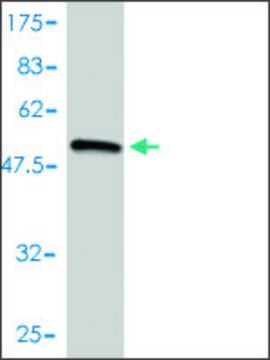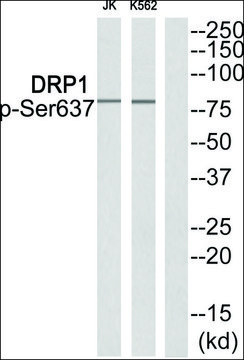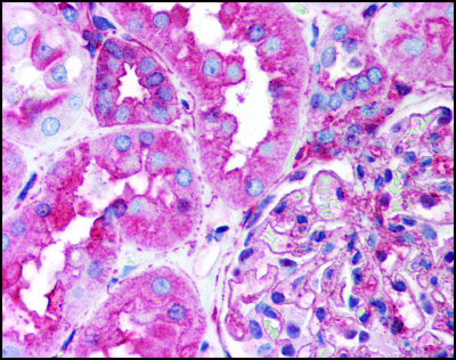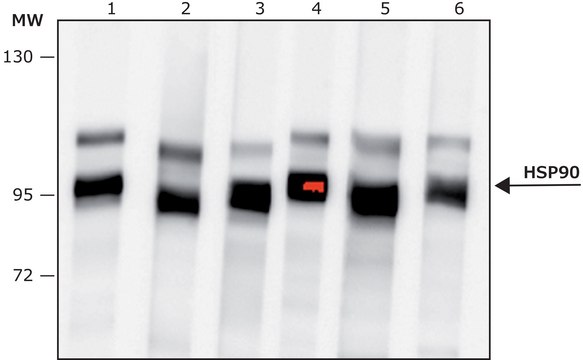MABC1106
Anti-Hsp90 alpha Antibody, clone 1G6-D7
clone 1G6-D7, from mouse
别名:
Heat shock protein HSP 90-alpha, Heat shock 86 kDa, HSP 86, Lipopolysaccharide-associated protein 2, LAP-2, LPS-associated protein 2, Renal carcinoma antigen NY-REN-38
登录查看公司和协议定价
所有图片(1)
About This Item
UNSPSC代码:
12352203
eCl@ss:
32160702
NACRES:
NA.41
推荐产品
生物来源
mouse
抗体形式
purified immunoglobulin
抗体产品类型
primary antibodies
克隆
1G6-D7, monoclonal
种属反应性
human
包装
antibody small pack of 25 μg
技术
ELISA: suitable
immunoprecipitation (IP): suitable
inhibition assay: suitable
western blot: suitable
同位素/亚型
IgG1κ
NCBI登记号
UniProt登记号
靶向翻译后修饰
unmodified
基因信息
human ... HSP90AA1(3320)
一般描述
Heat shock protein HSP 90-alpha (UniProt: P07900; also known as Heat shock 86 kDa, HSP 86, HSP86, Lipopolysaccharide-associated protein 2, LAP-2, LPS-associated protein 2, Renal carcinoma antigen NY-REN-38) is encoded by the HSP90AA1 (also known as HSP90A, HSPC1, HSPCA) gene (Gene ID: 3320) in human. HSP90 serves as a molecular chaperone that maintains the stability and functionality of numerous client proteins in an ATPase-dependent manner. It is known to interact dynamically with various co-chaperones that modulate its substrate recognition, ATPase cycle, and chaperone function. After the completion of the chaperoning process, properly folded client protein and co-chaperone leave HSP90 in an ADP-bound partially open conformation and finally, ADP is released from HSP90 which acquires an open conformation for the next cycle. HSP90 and its co-chaperones are also shown to modulate transcription at least at three different levels (a) by altering the steady-state levels of certain transcription factors in response to various physiological cues (b) modulating the activity of certain epigenetic modifiers, such as histone deacetylases, and (c) by participation in the eviction of histones from the promoter region of certain genes and thereby turn on gene expression. In its resting state, through the dimerization of its C-terminal domain, HSP90 forms a homodimer, which is defined as the open conformation. Upon ATP-binding, the N-terminal domain undergoes significant conformational changes and comes in contact to form an active closed conformation. Following the completion of its chaperoning activity, ATP molecule is hydrolyzed to ADP which then dissociates from HSP90 and directs the protein back to the resting state. This monoclonal antibody (clone 1G6-D7) is reported to inhibit both de novo tumor formation and expansion of already formed tumors in mice. (Ref.: Li, W., et al. (2012). Biochim. Biophys. Acta. 1823(3); 730 741; Zou, M., et al. (2017). Oncogene 36(15); 2160-2171).
特异性
Clone 1G6-D7 is a mouse monoclonal antibody that detects HSP90 alpha and HSP90 beta in human cells. it targets an epitope within 9 amino acids from the internal region.
免疫原
A recombinant fragment corresponding to 115 amino acids from the F-5 region of human HSP90 alpha.
应用
Anti-Hsp90 alpha, clone 1G6-D7, Cat. No. MABC1106, is a mouse monoclonal antibody that detects Hsp90 alpha, Hsp90 beta and has been tested for use in ELISA, Immunoprecipitation, Functional assay, Inhibition, and Western Blotting.
Immunoprecipitation Analysis: A representative lot immunoprecipitated Hsp90 alpha in Immunoprecipitation applications (Dong, H., et. al. (2016). Sci Rep. 6:20605).
ELISA Analysis: A representative lot detected Hsp90 alpha in ELISA applications (Zou, M., et. al. (2017). Oncogene. 36(15):2160-2171).
Affects Function Analysis: A representative lot blocked parental MDA-MB-231 cell invasion in a dose-dependent manner. (Zou, M., et. al. (2017). Oncogene. 36(15):2160-2171).
Western Blotting Analysis: A representative lot detected Hsp90 alpha in Western Blotting applications (Zou, M., et. al. (2017). Oncogene. 36(15):2160-2171).
Inhibits Activity/Function Analysis: A representative lot inhibited both de novo tumor formation and expansion of already formed tumors in mice. (Zou, M., et. al. (2017). Oncogene. 36(15):2160-2171).
ELISA Analysis: A representative lot detected Hsp90 alpha in ELISA applications (Zou, M., et. al. (2017). Oncogene. 36(15):2160-2171).
Affects Function Analysis: A representative lot blocked parental MDA-MB-231 cell invasion in a dose-dependent manner. (Zou, M., et. al. (2017). Oncogene. 36(15):2160-2171).
Western Blotting Analysis: A representative lot detected Hsp90 alpha in Western Blotting applications (Zou, M., et. al. (2017). Oncogene. 36(15):2160-2171).
Inhibits Activity/Function Analysis: A representative lot inhibited both de novo tumor formation and expansion of already formed tumors in mice. (Zou, M., et. al. (2017). Oncogene. 36(15):2160-2171).
质量
Evaluated by Western Blotting in MDA-MB-231 cell lysate.
Western Blotting Analysis: 1 µg/mL of this antibody detected Hsp90 alpha in MDA-MB-231 cell lysate.
Western Blotting Analysis: 1 µg/mL of this antibody detected Hsp90 alpha in MDA-MB-231 cell lysate.
目标描述
~90 kDa observed; 84.66 kDa calculated. Uncharacterized bands may be observed in some lysate(s).
外形
Format: Purified
其他说明
Concentration: Please refer to lot specific datasheet.
未找到合适的产品?
试试我们的产品选型工具.
法规信息
新产品
我们的科学家团队拥有各种研究领域经验,包括生命科学、材料科学、化学合成、色谱、分析及许多其他领域.
联系技术服务部门